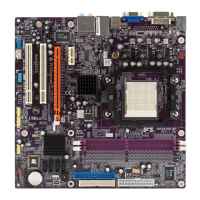26
Installing the Motherboard
PS2 Mouse Use the upper PS/2 port to connect a PS/2 pointing device.
PS2 Keyboard Use the lower PS/2 port to connect a PS/2 keyboard.
Parallel Port (LPT) Use LPT to connect printers or other parallel communica
(Optional) tions devices.
DVI Port Use the DVI port to connect the monitor.
VGA Port Connect your monitor to the VGA port.
Connecting I/O Devices
The backplane of the motherboard has the following I/O ports:
Audio Ports
Use the three audio ports to connect audio devices. The
first jack is for stereo line-in signal. The second jack is for
stereo line-out signal. The third jack is for microphone.
This concludes Chapter 2. The next chapter covers the BIOS.
The above port definition can be changed to audio input or
audio output by changing the driver utility setting.
Use the audio jacks to connect audio devices. The D port is
for stereo line-in signal, while the F port is for microphone
in signal. This motherboard supports 8-channel audio de-
vices that correspond to the A, B, C, and E port respec-
tively. In addition, all of the 3 ports, B, C, and E provide
users with both right & left channels individually. Users
please refer to the following note for specific port function
definition.
A: Center & Woofer D: Line-in
B: Back Surround E: Front Out
C: Side Surround F: Mic_in Rear
LAN Port Connect an RJ-45 jack to the LAN port to connect your
(Optional) computer to the Network.
USB Ports Use the USB ports to connect USB devices.
This motherboard may adopt 6-channel audio ports.
(Optional)

